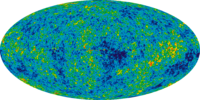
Photo from wikipedia
When subjected to flow, the structures of many soft-matter systems become anisotropic due to the symmetry breaking of the spatial arrangements of constituent particles at the microscopic level. At present,… Click to show full abstract
When subjected to flow, the structures of many soft-matter systems become anisotropic due to the symmetry breaking of the spatial arrangements of constituent particles at the microscopic level. At present, it is common practice to use various small-angle scattering techniques to explore flow-induced microstructural distortion. However, there has not been a thorough discussion in the literature on how a three-dimensional anisotropic structure can be faithfully reconstructed from two-dimensional small-angle scattering spectra. In this work, we address this issue rigorously from a mathematical perspective by using real spherical harmonic expansion analysis. We first show that, except for cases in which mechanical perturbation is sufficiently small, the existing small-angle scattering techniques generally do not provide complete information on structural distortion. This limitation is caused by the linear dependence of certain real spherical harmonic basis vectors on the flow-vorticity and flow-velocity gradient planes in the Couette shear cell. To circumvent the constraint imposed by this geometry, an alternative approach is proposed in which a parallel sliding plate shear cell is used with a central rotary axis along the flow direction. From the calculation of rotation of the reference frame, we demonstrate the feasibility of this experimental implementation for a fully resolved three-dimensional anisotropic structure via a case study of sheared polymers.
Journal Title: Physical Review E
Year Published: 2017
Link to full text (if available)
Share on Social Media: Sign Up to like & get
recommendations!